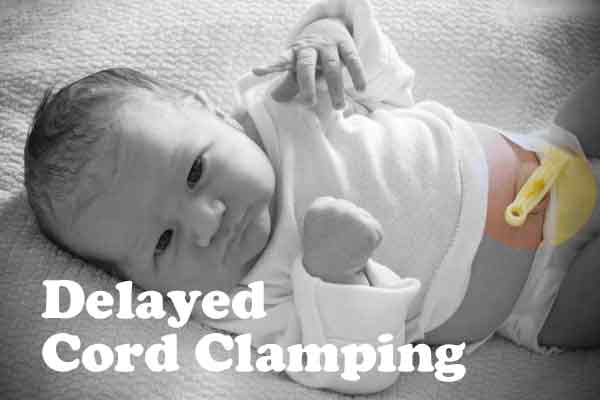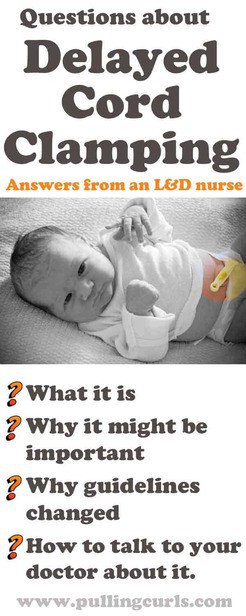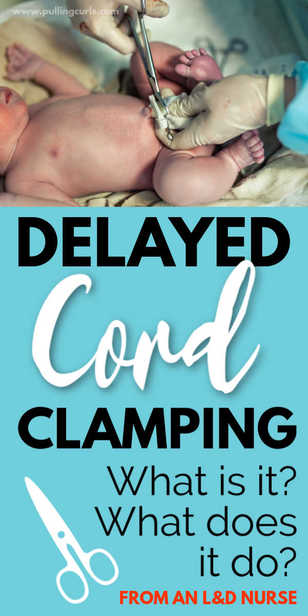It seems so harsh — one snip of the scissors and that baby that has relied on you for months is on their own. Oxygenating, crying, eating all on their own. Of course, I’d rather it be scissors than my teeth…. but I digress…. Delayed cord clamping is being requested more and more by patients anymore and I’m excited to share some info on it for you:

This post was originally written in June of 2015 and has been updated in 2017.
The newest NRP guidelines encourage Delayed Cord Clamping of 30-60 seconds, so most doctors should be on board — but some are slow to come around, so here are some issues our doctors had previous to the new guidelines:
1. You can’t be skin to skin (at least not right away) and it’s REALLY hard to hold your own baby at your crotch for an extended period of time, especially after you’ve pushed out a baby. I’m just keepin’ it real. Because here’s the main issue with cord clamping (according to the doctors I have spoken with):
**See below, but I know some of the doctors I work with still keep to this rule**
Many doctors believe the baby still needs to be kept at the same level as the placenta.
You have to think of the umbilical cord as an open system where blood can drain down to the baby or the blood can drain out the placenta (leaving the baby). The mom’s blood does not flow TO the baby, all of the blood on the baby’s side of the placenta is his/her own blood.
Also, a lot of babies have a really short cord that won’t reach anywhere near your chest even if it was at placenta level (some have monstrously long ones).
Read more about this down below (ETA, I have changed my views on this somewhat, so be sure to read this whole article — BUT our OB’s have not changed their view, so be sure to talk to your doctor!).
Many of our doctors delay skin to skin by holding the baby until they clamp — even though it’s not necessary.
2. Delayed resuscitation. That means that we’re not performing the initial steps of resuscitation that we do at each birth. Drying the baby, stimulating them to breathe and putting them skin to skin to stay warm. The baby is often left in the doctor’s hands open to air. The doctor can dry them off but it’s still kinda cold as they just hold them there.
4. It can’t really be as easily done in a c-section. Doctors still have an issue with holding the baby above the placenta.
As I note below though, it is still fine. Our doctors have begun delaying clamping for 30 seconds in the OR.
4. If the mom has a placental abruption or any issues relating to her own health, the doctor can’t wait holding the baby to help mom out. You have NO idea how fast a postpartum hemorrhage can go.
5. Increased incidence of Jaundice. You might have heard of babies who “turned yellow” or had to go under the blue lights. Jaundice is a bi-product of extra red blood cells the baby isn’t able to get out of their system fast enough, so they stay inside turning them yellow. This can require extra days in the hospital or blue lights at home. You can understand that by giving them MORE red blood cells to get rid of, it can increase the chance of this.
6. If you’re doing cord blood collection you need a large enough sample to make it worth the money, and if all the blood goes out then that can’t happen. Although, frankly, I feel like I am seeing less and less cord blood collection these days.
Check out this stuff to help your baby’s cord dry faster!
Have you seen the owlet baby monitor? Look at my Owlet Monitor post, or shop directly here — Now available with Android!
Benefits of Delayed Umbilical Cord Clamping
The study is talking about delaying it 30-60 seconds, and while that SEEMS short, it can feel like a lifetime... :)
*I found this great ACOG page about all the pro’s and cons, super interesting*
1. The extra iron can be beneficial to the baby in their first year of life and possibly prevent anemia.
2. Increased blood volume and decreased intracranial hemorrhage in preterm newborns.
It is now the norm, according to NRP guidelines — so be sure to talk to your doctor about it in one of your appointments!
**After writing this post I saw this YouTube video. It really changed my mind about delayed cord clamping even when NRP wasn’t recommending it.
ACOG is THE journal for OB’s — feel free to send them this link. It’s not like you’re handing them “Journal of Mother Earth Birth”. 🙂
You might also be interested in my post about placental encapsulation:
Hopefully, your doctor is on board. It will be interesting to see how guidelines change as studies on this improve.
Be sure to check out my free prenatal class:

And be sure to check out all my other pregnancy posts:
[pt_view id=”0fae3f0c8d”]











Christina says
Delaying cord clamping has never resulted in a lack of skin to skin contact with my children. My children were placed on my chest and covered with blankets the same as my children who did not experience delayed cord clamping.
Hilary says
Yeah, that Youtube clip I put up that showed if the baby was on the chest it didn’t result in any blood loss was interesting, our doctors won’t do that, so I don’t know. Except that they don’t take kindly to my advice. 🙂 I know that. 🙂
Jennifer says
I asked my doctor not to cut my youngest son’s umbilical cord immediately so the cord blood could drain back into his body instead of being wasted or saved for “maybe someday” and costing us a ton of money. It was able to benefit him immediately. My doctor held him for a short time while the blood drained. I had a healthy pregnancy, delivery and baby. Obviously delayed clamping and things that aren’t necessarily CRUCIAL should go out the window immediately if there’s any kind of risk or possibility of risk. Each mom should do her own research, know her body, talk to her doctor and make an informed decision for herself and her baby.
Hilary says
I don’t get a lot of parents asking the doctor. I get a lot asking me but I tell them to ask the doctor because I’m not the one down there. I’m glad yours listened!
Jennifer says
Absolutely! I have tremendous respect and trust in my doctor. If he had said I don’t think you should do this and here’s why, I certainly wouldn’t have. I’m not sure why someone wouldn’t ask their doctor! If they don’t trust his/her professional opinion, maybe they should find a new doctor ?
Hilary says
I think they probably forget in the moment (as do I). Doctors don’t think to ask. And it takes extra time….
Stephanie says
OMG! Telling moms that they “can’t” be skin-to-skin with delayed cord clamping because it’s “difficult” is actually really terrible, harmful guidance. Yikes!
Tara says
I was excited to find my hospital is moving to have this be the norm for babies that don’t have any issues right at birth. My last baby wasn’t able to do it because he had meconium in his fluid so they had to whisk him off to be suctioned right away. I’m due in a week and am really hoping this baby can have the delay. Two of my children have struggled with anemia in their first two years of life so I’would love to give this baby an extra boost of iron to maybe avoid that!
Heather says
Wow your lack of education as an L&D nurse never cease to amaze me on these posts 🙁
No, the keeping baby level stuff isn’t accurate. Yes, you can hold baby. Yes, you can have them do the unsafe practice of suctioning their noses.
Can you please just start following a more accurate blog: http://www.evidencebasedbirth.com?
Thanks
Hilary says
A) ouch. Mean. Rude. Did you read the while article? I will say that the doctors I have worked with will not allow skin to skin due to the ACOG guidelines. But at the end I watched that video and was convinced that could be safe. And I was for it in certain circumstances. B)because I am traveling in the car I did go to that site. I actually agree with a lot that is said. But she has some facts about hospital births wrong. I think it’s a good way to get educated for the most part. However. L&d is a delicate balance between patients wishes and their their wish to sue you when mother nature doesn’t go their way. You can have them sign thay you are going against policy and they have been informed of the risks and they can still sue you and win. It’s frustrating and torte law (I think I spelled that right) needs to change for us to change. Lawyers have killed birth. Not doctors or nurses. I’d love the changes. Especially fetal monitoring. But I live in fear of getting sued. That’s all. 🙂
Amanda says
As a midwife who has practiced delayed cord clamping and immediate skin to skin contact for the last 10 years I can assure you that the baby does not need to be held at any height ( basic physiology ), research has shown no increased risk of jaundice, and it is now standard practice in the UK.
Doctors have no right to “allow ” women to do anything with their bodies or their babies, birth should be about empowering women to make the decisions that are correct for them .
Hilary says
It is not standard practice in the US. Our neos don’t recommend it still. I frankly see very little on either side. I do recommend people talk to their doctor if it is important to them.
Brittany says
It’s refreshing to see an article that shares both sides of the coin and an individual that is open enough to share that their opinions have evolved. ?
It saddens me when there’s aggression or anger with differences of opinion (as seen by some comments). My dream is to become a Licensed/Certified Professional Midwife and I look forward to one day have a productive dialogue with professionals that have a different point of view. Thank you for sharing and your openness.
Hilary Erickson says
Yeah, our doctors did a 180 once nrp changed their guidelines… funny how that happens!